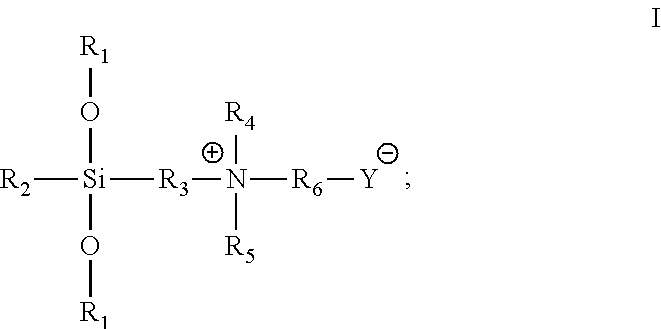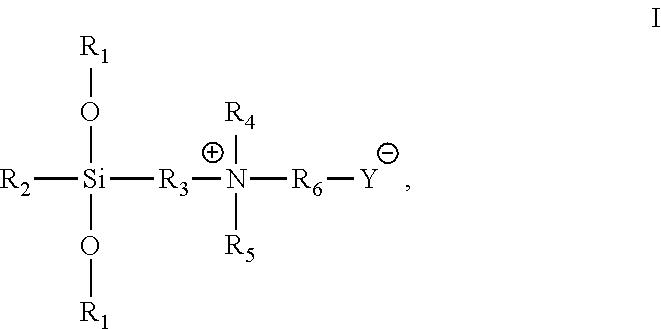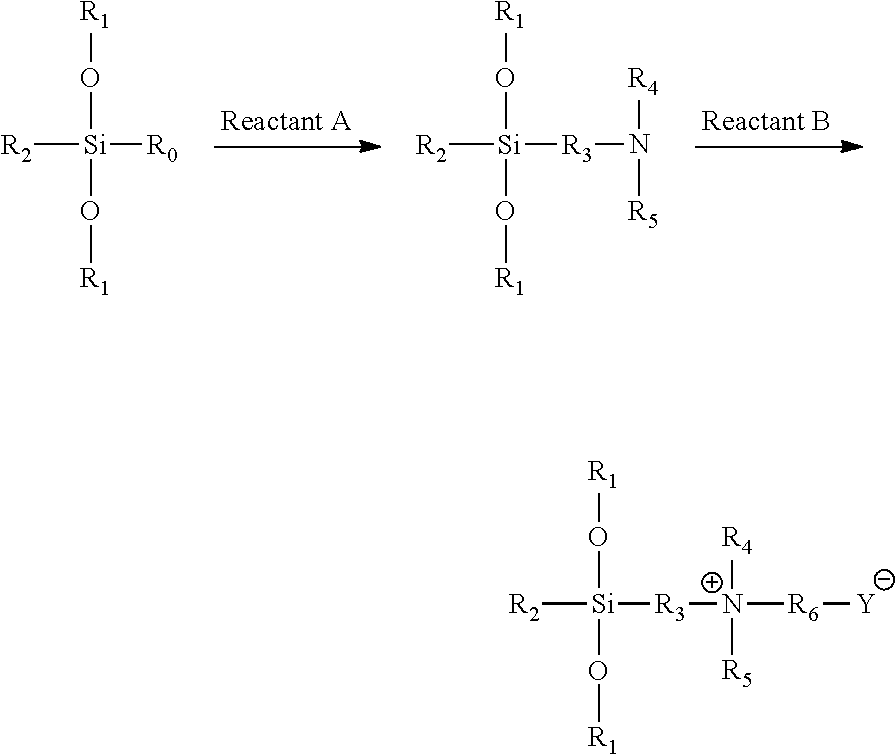Antimicrobial compound and preparation thereof
- Summary
- Abstract
- Description
- Claims
- Application Information
AI Technical Summary
Benefits of technology
Problems solved by technology
Method used
Image
Examples
embodiment 1
[0030]98.6 g triethoxysilane [(CH3CH2O)3SiH] was weighted and added to a round-bottomed flask with mechanical stirring and a reflux apparatus. After 0.2 ml of chloroplatinic acid / isopropanol catalyst was added, 51.2 g dimethylallylamine [CH2═CHCH2N(CH3)2] was slowly added dropwise via a dropping funnel with stirring at 60° C. After the dropwise addition was completed, the reaction was continued for 1 h. The temperature was reduced to 50° C., and then 73.2 g propane sultone [
hereafter referred to simply as 1,3-PS] (dissolved in 400 mL absolute ethanol) was added dropwise. After the dropwise addition was completed, the reaction was continued for 1 h, to yield a white precipitate. The precipitate was isolated by centrifugation and purified several times, to yield an organosilicon-sulfonic acid type betaine antimicrobial agent, with the structural formula: (CH3CH2O)3Si(CH2)3+N(CH3)2(CH2)3SO3−, and having a minimum inhibitory concentration (MIC) of 15 mg / mL and a minimum bactericidal con...
embodiment 2
[0031]107.8 g methyldiethoxysilane [(CH3CH2O)2CH3SiH] was weighted and added to a flat-bottomed flask with magnetic stirring and a reflux apparatus. After 0.25 g SiO2 supported platinum-gold catalyst was added, 88.9 g diethylallylamine [CH═CHCH2N(CH2CH3)2] was slowly added dropwise via a dropping funnel with magnetic stirring at 30° C., and the reaction time was started. After 8 h of reaction, the catalyst was recovered by filtration under reduced pressure. Then, the filtrate was collected, to which 97.6 g 1,3-PS (dissolved in 400 mL absolute ethanol) was added dropwise. The reaction was continued at 30° C. for 10 h, to yield a white precipitate. The precipitate was filtered and purified by washing with ethanol several times, to yield an organosilicon-sulfonic acid type betaine antimicrobial agent, with the structural formula: (CH3CH2O)2SiCH3(CH2CH3)3+N(CH3)2(CH2)3SO3−, and having a MIC of 25 mg / mL and a MBC of 30 mg / mL for both E. coli (8099) and S. aureas (ATCC6538).
embodiment 3
[0032]107.6 g methyldiethoxysilane [(CH3CH2O)2CH3SiH] was weighted and added to a flat-bottomed flask with magnetic stirring and a reflux apparatus. After 0.20 g of Karstedt type platinum-gold catalyst was added, 68.2 g dimethylallylamine [CH2═CHCH2N(CH3)2] was slowly added dropwise via a dropping funnel with magnetic stirring at 20° C., and the reaction time was started. After 24 h of reaction, the catalyst was recovered by filtration under reduced pressure. Then, the filtrate was collected, to which 93.2 g sodium chloroacetate [ClCH2CO2Na] (dissolved in 400 mL absolute ethanol) was added dropwise. The reaction was continued at 20° C. for 24 h, to yield a white precipitate. The precipitate was isolated by centrifugation and purified several times, to yield an organosilicon carboxylic acid type betaine antimicrobial agent, with the structural formula: (CH3CH2O)2SiCH3(CH2)3+N(CH3)2CH2CO2−, and having a MIC of 20 mg / mL and a MBC of 25 mg / mL for both E. coli (8099) and S. aureas (ATCC6...
PUM
 Login to View More
Login to View More Abstract
Description
Claims
Application Information
 Login to View More
Login to View More - R&D
- Intellectual Property
- Life Sciences
- Materials
- Tech Scout
- Unparalleled Data Quality
- Higher Quality Content
- 60% Fewer Hallucinations
Browse by: Latest US Patents, China's latest patents, Technical Efficacy Thesaurus, Application Domain, Technology Topic, Popular Technical Reports.
© 2025 PatSnap. All rights reserved.Legal|Privacy policy|Modern Slavery Act Transparency Statement|Sitemap|About US| Contact US: help@patsnap.com



